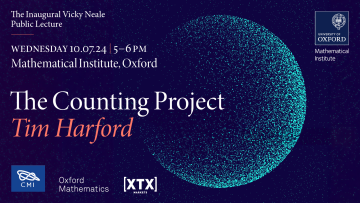Approximate equivalence relations
Hrushovski, E
(19 Jul 2024)
Graphs without a 3-connected subgraph are 4-colorable
Bonnet, É
Feghali, C
Nguyen, T
Scott, A
Seymour, P
Thomassé, S
Trotignon, N
(09 Feb 2024)
http://arxiv.org/abs/2402.06338v2
Detecting Temporal shape changes with the Euler Characteristic Transform
Marsh, L
Zhou, F
Qin, X
Lu, X
Byrne, H
Harrington, H
Transactions of Mathematics and Its Applications
volume 8
issue 2
(04 Jul 2024)
The Vicky Neale Public Lecture recognises the invaluable contribution to mathematical education of the late Vicky Neale. In this lecture, economist and broadcaster Tim Harford looks at how data built the modern world - and how we can use it to build a better one.
5pm, Wednesday 10 July, 2024
Mathematical Institute,Oxford
A principle of maximum entropy for the Navier–Stokes equations
Chen, G
Glimm, J
Said, H
Physica D: Nonlinear Phenomena
volume 467
(01 Jul 2024)
Characterising cancer cell responses to cyclic hypoxia using mathematical modelling
Celora, G
Nixson, R
Pitt-Francis, J
Maini, P
Byrne, H
(2024)
Approximate solutions of a general stochastic velocity-jump model
subject to discrete-time noisy observations
Ceccarelli, A
Browning, A
Baker, R
(28 Jun 2024)
http://arxiv.org/abs/2406.19787v4
subject to discrete-time noisy observations
The handlebody group is a virtual duality group
Petersen, D
Wade, R
(24 May 2024)
http://arxiv.org/abs/2405.15515v1
Augmentations of Forman’s Ricci curvature and their applications in community detection
Fesser, L
Serrano de Haro Iváñez, S
Devriendt, K
Weber, M
Lambiotte, R
Journal of Physics: Complexity
volume 5
issue 3
(12 Aug 2024)


